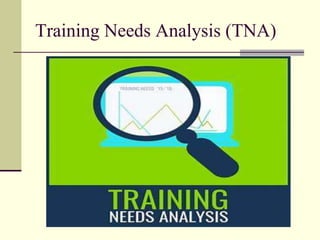TNA
The document discusses training needs analysis (TNA). TNA aims to identify gaps between current and desired job performance or skills. It involves a 5-step process: 1) identify problem needs through context analysis and goal-setting; 2) determine the appropriate analysis method; 3) collect data through interviews, surveys, documents and observations; 4) analyze the data qualitatively or quantitatively to determine solutions; 5) provide a report and presentation with feedback. The document also discusses McGhee and Thayer's 3-level analysis model for TNA at the organizational, operational and individual levels. It provides examples of analyzing training needs at each level. Finally, the document lists 8 ways to motivate employees in training, such as

Recommended
Recommended
More Related Content
Similar to TNA
Similar to TNA (20)
Recently uploaded
Recently uploaded (13)
TNA
- 1. Training Needs Analysis (TNA)
- 5. Why do we need a Training Needs Assessment? First, identify dissatisfaction with the current situation and desire for change as similarities among the requests. Each request implies that a gap or discrepancy exists between what is and what could be or should be. A learning or performance gap between the current and desired condition is called a need. TNA aims at the following situations. Solving a current problem Avoiding a past or current problem Creating or taking advantage of a future opportunity Providing learning, development or growth
- 13. Step One: Identify Problem Needs: a. Determine the context b. Perform gap analysis c. Set objectives Step Two: Determine Design of Needs Analysis: a. Establish method selection criteria b. Assess advantages and disadvantages for methods
- 14. Step Three: Collect Data a. Conduct interviews b. Administer questionnaires and surveys c. Review documents d. Observe people at work Step Four: Analyze Data: a. Conduct qualitative or Quantitative Analysis b. Determine solutions/recommendations Step Five: Provide Feedback a. Write report and make oral presentation.
- 16. McGhee and Thayer's Three-Level Analysis The model provides a systematic means of conducting a TNA at three levels: organizational, operational (or task), and individual (or person).
- 17. Organisation Analysis The organisation analysis allows you to view the performance of the organisation. It is interesting to note that whilst this analysis does not indicate a specific training need of an individual it can highlight performance problems in specific departments within the organisation. The following areas will assist in your analysis: Profit and Loss statements by department Employee turnover Downtime Organisations Business Plan (Objectives and Goals)
- 18. Operational Analysis At the operational analysis you will be concerned with what Knowledge, Skills and Abilities are required to perform certain jobs/tasks. This information can be gained through: Quality Assurance Procedures Interviewing Heads of Departments Obtaining Job Descriptions
- 19. Person Analysis This is where you analyse how well the team or individual performs the task/job. Again a range of tools are available to evaluate the extent of teams and individuals skills, knowledge and abilities. These include: Interviewing staff (about the job) Observation 'On-the-job' Job Profile
- 21. Motivation training 8 Ways to motivate your employees in their training 1. Incorporate training in organisational culture First things first, if your organisational culture doesn’t support training, then you’re going to find it difficult to motivate and engage the employees.
- 22. 2. Give regular feedback If your employees are completing training content without getting any feedback, they’ll start to feel like they’re dropping their work down a well, never to be seen again. 3. Keep it interesting Some people have the strange notion that learning is supposed to be hard work, and being boring is all part of the package. Don’t bore your employees. If you’re pumping out the same lifeless training documents without a thought for learner engagement, then don’t be surprised if your learners don’t engage with them.
- 23. 4. Contextualise your employees’ training Going back to the point about giving regular feedback, we can see how important it is that your learning programme has meaning for your employees. If they can’t see what the ultimate goal of their training is, they’re not as likely to become invested. Make the training relevant for the individual Here’s why the sheep-dip approach to training doesn’t work: If you’re pushing the same training to everyone, then everyone is going to find themselves working through content that is of no use to them. This speedbump can kill the momentum in their learning journey and it might drive them away altogether
- 24. Identify employee strengths Creating learning pathways for each department will go a long way towards reducing friction and keeping motivation levels up, but imagine what would happen if you could create personalised learning pathways for every employee in the business. Emphasise the long-term career prospects The majority of your employees will have an interest in the continued success of the company as a whole – but even the most selfless soul will have one eye on how the training can benefit them personally. Recognise their expertise We’ve already hinted that one key to motivating people to do anything is to convince them that it’s not a complete waste of time. Right now, in your organisation, there are hidden experts who have trained hard to master a particular topic. If they don’t have an outlet for sharing their expertise, they might feel like they learned it all for nothing.